Zoo's aardvark contributes to national animal milk research
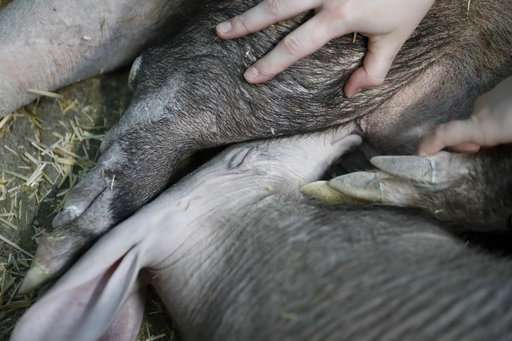
An aardvark in Cincinnati is sharing his mother's milk—with scientists in Washington.
Ali the aardvark is mother to Winsol, who in late December became the zoo's first healthy aardvark newborn since 1994. Cincinnati Zoo staffers draw milk samples from the 13-year-old mom every Friday, then send them to the Smithsonian's National Zoo in Washington and the Smithsonian's Exotic Animal Milk Repository.
The milk contributes data for creating milk alternatives for animal babies. The regular collection allows researchers to analyze the milk's composition and record changes. Artificial recipes tailored for specific periods in the nursing cycle can be critical to zoos that must hand-raise a newborn animal that's unable to feed from its mother.
"This allows us to determine the basis of the milk, what's in it, and if it changes ... how it changes in its formulation over time," said Mike Dulaney, mammals curator for the Cincinnati Zoo. "We have sent them gorilla milk samples, hippo milk samples, and now aardvark milk samples, so this will increase the base knowledge that they have which not only can help us, but all other zoological facilities around the world."
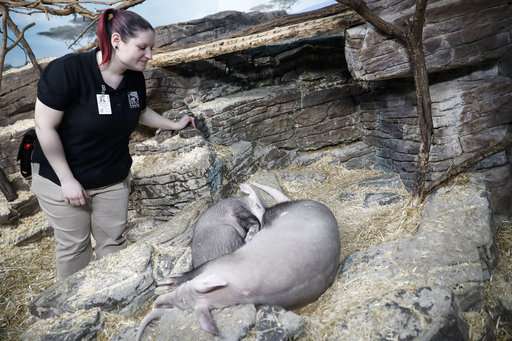
The Cincinnati Zoo benefited from Smithsonian research in feeding Fiona, the premature hippo born Jan. 24, 2017, at a dangerously low 29 pounds (13 kilograms). She was unable to stand to feed from her mother Bibi.
"They sent milk to us so that we could analyze it, so that we could send that information back to their nutritionist, so that their nutrition staff and keepers staff could come up with a formula that was as close as possible to be able to fit mother's milk for Fiona," recounted scientist Michael Power of the Smithsonian's Conservation Biology Institute.
The young hippo has thrived, becoming a social media sensation and a star attraction in Cincinnati.
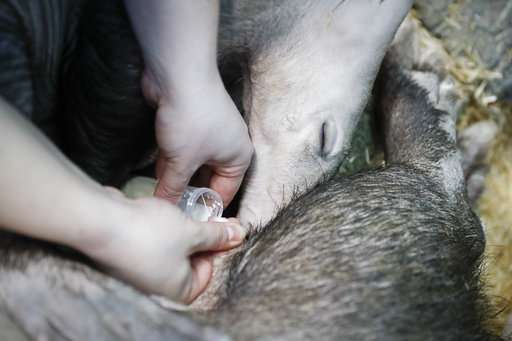
The repository has some 15,000 samples from 185 species, but last received aardvark milk in 1992. There aren't a lot of opportunities, and the milking itself is tricky business.
"There's not that many aardvarks in captivity around, and especially being bred, and especially where the keepers and everything have had interactions with the animal so that you can know you can do this," Power said. "They have to do it safely ... for both the aardvark and themselves. You can imagine going up to a mother, a mammal, and trying to get milk from it. It might not be too happy about that.
"So we have to know the personality of the animal," Power said.
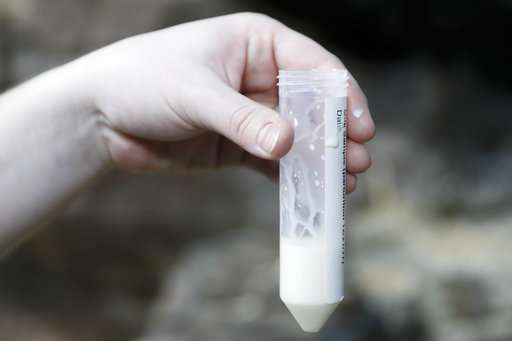
Once Winsol begins to feed, zookeeper Danielle Holste must quickly draw samples from one of Ali's available nipples without disturbing the hungry youngster. Staffers gently adjust the animals' positions to keep Ali from accidentally rolling onto Winsol. Drawing milk by hand, it takes only minutes to gather several milliliters for analysis.
The nocturnal, insect-eating animals are native to Africa. The Cincinnati Zoo's aardvarks live in the facility's Night Hunters area.
-
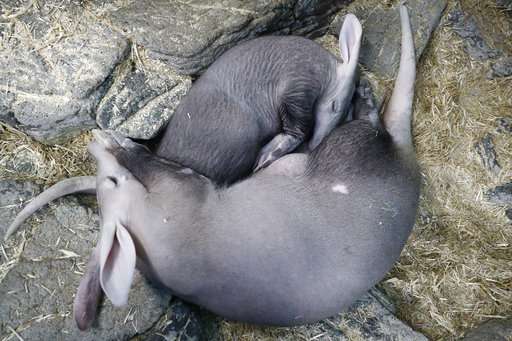
In this April 6, 2018, photo, Winsol, an aardvark born in December, above, rests alongside his mother Ali at the Cincinnati Zoo & Botanical Garden in Cincinnati. The zoo has been collecting and sending milk samples from Ali to the Smithsonian's National Zoo and the Smithsonian's Exotic Animal Milk Repository for study. (AP Photo/John Minchillo) -
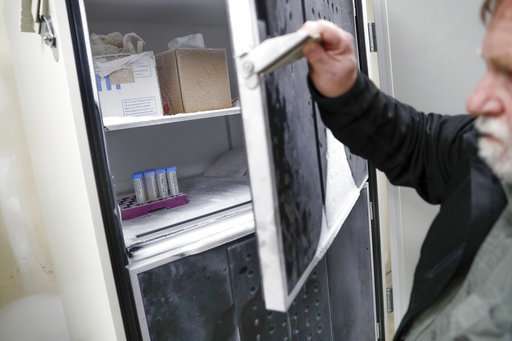
In this April 6, 2018, photo, Mike Dulaney, curator of mammals at the Cincinnati Zoo & Botanical Garden, closes a refrigerator that holds milk samples from Ali, a 13-year-old aardvark, in their medical facilities in Cincinnati. The zoo has been collecting and sending milk samples from Ali to the Smithsonian's National Zoo and the Smithsonian's Exotic Animal Milk Repository for study. (AP Photo/John Minchillo) -
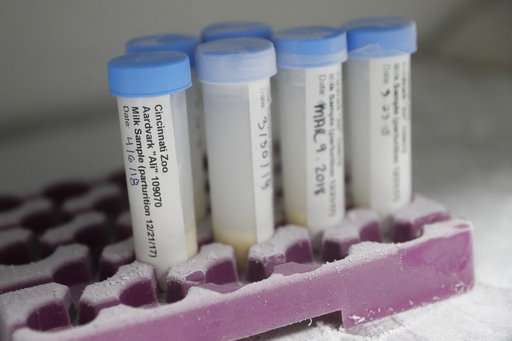
In this April 6, 2018, photo, milk samples taken from Ali, a 13-year-old aardvark, are stored in a freezer at the Cincinnati Zoo & Botanical Garden's medical facilities in Cincinnati. The zoo has been collecting and sending milk samples from Ali to the Smithsonian's National Zoo and the Smithsonian's Exotic Animal Milk Repository for study. (AP Photo/John Minchillo) -

In this April 6, 2018, photo, Winsol, an aardvark born in December, stands beside his mother Ali in their enclosure at the Cincinnati Zoo & Botanical Garden in Cincinnati. The zoo has been collecting and sending milk samples from Ali to the Smithsonian's National Zoo and the Smithsonian's Exotic Animal Milk Repository for study. (AP Photo/John Minchillo) -
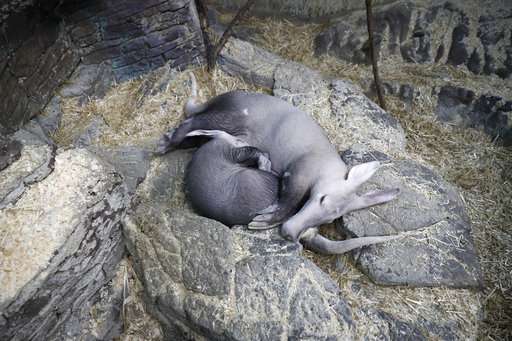
In this April 6, 2018, photo, Winsol, an aardvark born in December, left, rests alongside his mother Ali at the Cincinnati Zoo & Botanical Garden in Cincinnati. The zoo has been collecting and sending milk samples from Ali to the Smithsonian's National Zoo and the Smithsonian's Exotic Animal Milk Repository for study. (AP Photo/John Minchillo) -
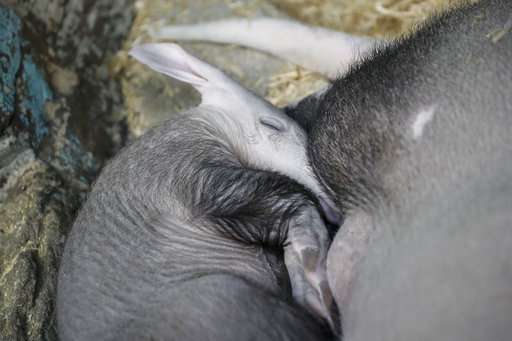
In this April 6, 2018, photo, Winsol, an aardvark born in December, left, rests alongside his mother Ali at the Cincinnati Zoo & Botanical Garden in Cincinnati. The zoo has been collecting and sending milk samples from Ali to the Smithsonian's National Zoo and the Smithsonian's Exotic Animal Milk Repository for study. (AP Photo/John Minchillo)
© 2018 The Associated Press. All rights reserved.















